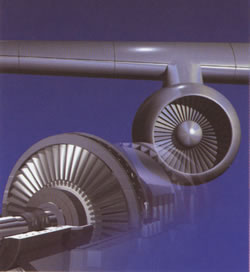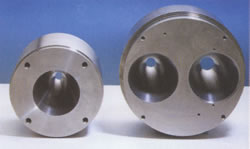Tungsten Alloys
Stellites
Cobalt-chromium-tungsten alloys (also Mo, Ni, Fe, C, Si and B can be contained), frequently called stellite, are a group of wear resistant alloys which are used for bearings, valve seats and pistons, mill inliners, etc., i.e. applications where a tough wear resistant material is required. They are applied either by hard facing as welding electrodes or powder spraying, or as massive forms produced by casting. The properties of stellite metal cutting tools are in the middle between those of high speed steels and cemented carbides.
Superalloys

Superalloys are nickel, cobalt or iron based alloys with high contents of tungsten, molybdenum, tantalum and, more recently, also rhenium. Sixteen and more elements can be contained. Their important properties are: high-temperature strength, high creep strength at high temperature, high thermal fatigue resistance, good oxidation resistance, excellent hot corrosion resistance, air melting capability, air or argon remelting capability, good welding properties and ease of casting. Tungsten accounts for solid solution strengthening, strengthening by formation of intermetallic compounds (e.g. Co3W), and formation of carbides. Superalloys are used in aircraft engines, marine vehicles, and stationary power units as turbine blades and vanes, exhaust gas assemblies and burner liners. They are also used as construction material for furnace parts.
Tungsten Heavy Metal Alloys

They are a group of two-phase composites, based on W-Ni-Fe or W-Ni-Cu, prepared by liquid phase sintering. Tungsten is the main component (90-98%). Ni-Fe or Ni-Cu serves as the ductile binder phase for the brittle W grains. These alloys are characterized by a unique combination of high density (17-19 g/cm3), high strength and ductility. They are used as counterweights in airplanes, rotating inertia members, x-ray and ã-radiation shielding, as rigid tools for machining, for darts, for weights in golf club heads, as well as, for ordnance purposes (high kinetic energy penetrators, fragmentation devices, etc.)
Tantalum – Tungsten Alloys
Tungsten is frequently used as an additive to tantalum (max. 10 % W) and niobium (max. 15 % W) to improve high-temperature strength and creep resistance.






 sales@chinatungsten.com
sales@chinatungsten.com